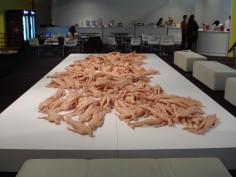Richard Dupont
理查德·杜邦
리처드 듀퐁
Terminal Stage

source: leverhouseartcollection
Richard Dupont is engaged in the centuries long traditions of figurative sculpture, yet he uses his own body as subject matter, advanced technological devices, and twenty-first century materials to achieve realistic, although drastically manipulated, human figures. Dupont has created nine self-portraits that are laterally and horizontally manipulated so that they are radically distorted and can only be seen as an accurate, complete body from one vantage point.
TERMINAL STAGE is intended as a public art piece. The involvement of the viewer is essential in the meaning of the piece. It was also conceived as a site-specific intervention. Lever House was the first modern structure built on the New York City grid, and it is a highly charged and symbolic site, emblematic of the revolutionary changes in architecture and urban space that were to take place over the half century since its construction. The lobby space confounds traditional readings of ‘public’ and ‘private’ as well as ‘interior’ and ‘exterior’ space, and TERMINAL STAGE emphasizes the instability of a single reading of the site. The lobby space is both a ‘terminal’ and a ‘stage’. The transparency of the site emphasizes the implication of the viewer, the pedestrians, and all of the traffic flow around the building.
Dupont’s effective insertion of his own body into the vast depersonalized matrix of biometrics and industrial design began in 2004 with a full body laser scan. To accomplish the body scan, Dupont traveled to a General Dynamics facility on the Wright-Patterson Air Force Base, Ohio, and participated in a broad anthropometry study. The examination involved extensive manual body measurement (traditional anthropometry) as well as a full body laser scan. The data from such studies are sold to both the military and large clothing manufacturers who use the generic averages to design anything that interfaces with the body, such as ejection seats, flack jackets, blue jeans, socks. These systems and designs are concerned with averages and the standardization of the body.
Dupont, however, is not interested in average body types, and through the use of computer electronic programming he is able to maneuver his real form into surreal shapes that are then converted into a three dimensional model and cast in polyurethane resin. As Dupont states, ‘The work actually represents the ‘anti-self portrait,’ because the body image is reduced to numerical information and computerized polygons that are mechanically translated by the computer into forms, resulting in an object that exemplifies the monolithic force of the digital information age.’ His works are rooted in the tradition of those who have attempted to portray, in representational form, the visions that lie beyond rational perception. Dupont’s work makes reference to the hallucinatory effects of technology, with its promise of transcendence and its equally potent destructive effects.
.
.
.
.
.
.
.
source: artspace
Known for his work in sculpture, drawing, and printmaking, Richard Dupont has made a career out of studying the human figure. Using the body as his subject, Dupont explores the way in which it represents manifestations of power and control, and looks at how the body has been mapped and represented throughout history. In 2001, Dupont began a project in which he scanned and replicated his body in smaller scale, a process that led to several diverse projects, including full-scale nude sculptures, as well as a series of bodiless heads. Interested in the way we scrutinize ourselves, Dupont sees his reproductions of the human figure as a way to highlight the idea of “self-surveillance,” and to note the way in which we map our lives through accumulating details.
Dupont has been the subject of solo exhibitions at Lever House in New York and Middlebury College Museum of Art, and has been included in group exhibitions at institutions such as the Flag Art Foundation, the Museum of Arts and Design, and the International Print Center New York.
.
.
.
.
.
.
.
source: artsynet
Sculptor Richard Dupont explores issues of the human body, self-perception, and identity. Using body scan technology, Dupont creates outsized nude polyurethane figures of himself, manipulating each replica so that the sculptures appear distorted from all but one angle, and otherwise seem flattened, widened, or wavy. “It’s not just retinal, it’s also physiological,” he says. “There’s a queasiness, an anxiety caused by the brain not being able to understand the two things at once.” In the installation, Terminal Stage (2008), nine of Dupont’s works were displayed in a glass room, creating an intentionally discomfiting and voyeuristic viewer experience.
.
.
.
.
.
.
.
source: charestweinberg
Richard Dupont was born in 1968 in New York. He currently lives and works in New York. He has participated in numerous exhibitions in The United States and abroad, most notably solo exhibitions Terminal Stage at The Lever House in 2008 and Between Stations at The Hudson Valley Center For Contemporary Art 2008. His work is in public collections including The Museum of Modern Art, The Whitney Museum of American Art, The Cleveland Museum of Art, and The New York Public Library.

